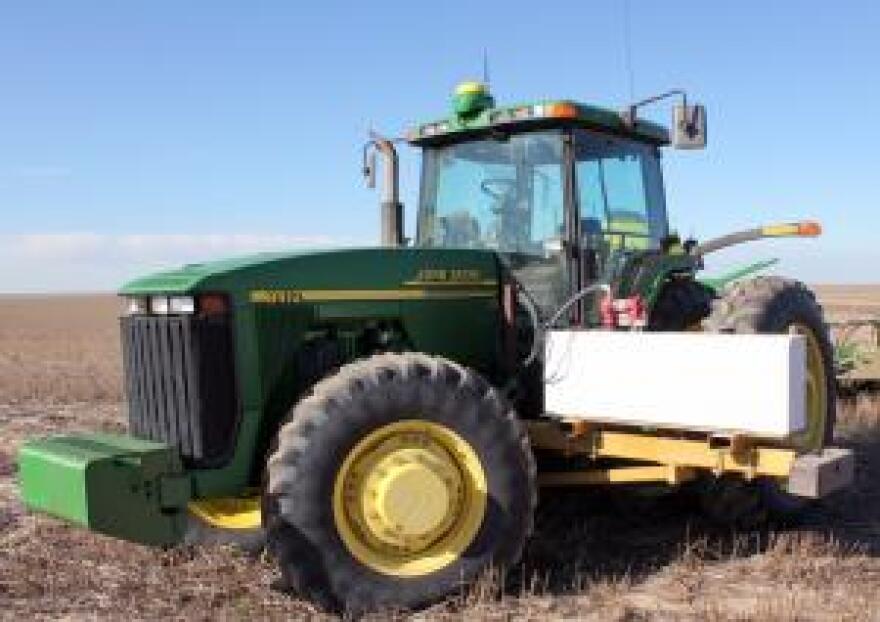Efficiency is the name of the game these days in agriculture: conserving money, time and manpower. But taking the farmer out of the tractor? Though it sounds like something out of a science fiction cartoon, it may be coming.
A robot tractor doesn’t quite have the same allure as the Jetsons’ flying car, but it’s likely to be more practical for everyone involved.
By Eric Durban.
“Ultimately, productivity leads to profitability,” said Susanne Kinzenbaw Veatch, vice president and chief marketing officer for Kinze Manufacturing, the Iowa-based agricultural equipment manufacturing company hoping to bring autonomous farm technology to market.
Imagine cruising down a two-lane highway as you approach a Kansas farmer planting winter wheat. From a distance the scene looks typical. The tractor moves right to left, left to right, across a field. When you get close to the tractor cab, though, you realize the farmer’s hands are off the wheel and he’s looking backwards. Still, the machine runs in a straight line planting winter wheat.
It’s all made possible by GPS. On many large farm operations in the U.S., computer guidance is already common, said Jeremy Brown, president of Jaybridge Robotics, a Massachusetts-based company partnering with Kinze.
“That actually made (farming) a good target to just take what is another step, but not a giant step, to full autonomy,” Brown said.
Jaybridge envisions full autonomy — basically, a farmer-less tractor – as an important tool on farms of the future. Instead of having a person at the helm, a system of sensors and complex algorithms would keep the tractor on task.
http://www.youtube.com/watch?feature=player_embedded&v=Usadb4bBn4k
The autonomous farming vision isn’t just about taking the farmer out of the tractor, it’s about redistributing his time elsewhere.
Finding and keeping quality workers is becoming increasingly difficult in farm country and Veatch says that’s exactly what got the wheels turning with autonomy.
“It can run around the clock, whereas the human body fatigues,” Veatch said.
That notion wasn’t lost on western Kansas farmer Jason Ochs as he sat inside his tractor planting his last few acres of wheat.
“You put in such long hours at harvest and if you have one less person that’s needed, or you still have the same number of people helping but they can relieve somebody else a little bit during the day, it would make it much nicer,” Ochs said.
Much of agriculture has to be done in narrow windows of time to maximize yields and quality – and that’s before you even consider disruptive weather. Ochs relies on family members from as far away as Pennsylvania to help out during the harvest and must find other hired help to fill gaps.
“We can lose a lot of money just because we’re unable to harvest everything,” Ochs said.
The more that is automated and mapped out in his operation, the less Ochs has to worry about human error. He calculates that just overlapping a foot on planting his 3,200 winter wheat acres costs him $2,600 in input costs. Across the farm, the savings can add up and the GPS he already has essentially pays for itself in just a couple of years.
Two years into developing its autonomous farming technology Kinze is working on its pricing and sales pitch. The technology will likely be targeted toward larger growers with more than 500 acres of row crops, Veatch said.
http://www.youtube.com/watch?feature=player_embedded&v=k0Lj_5MBu8w
Whether or not farmers will have to buy additional tractors, which can set them back hundreds of thousands of dollars, remains to be seen.
The technology has only been tested on Kinze’s farmland, but the company hopes to get it to real farmers soon. After all, technology moves fast and tractor market leaders John Deere and Case IH are also active in the autonomous farming arena.
As he waits for a release date, Ochs has seen Kinze’s online videos, which show the technology retrofitted on a John Deere tractor.
“I just thought that was super neat,” Ochs said.
The father of three was concerned about safety until he realized his own eyes may not be as reliable as this technology. In Kinze's model, one tractor-mounted radar detects metallic and water-based objects, like people or livestock, while another laser finder tracks dry things like fence posts.
Brown, at Jaybridge, said the tractor would stop many meters short of an obstacle -- much like some cars do today.
“In adaptive cruise control, if your car has this radar and it sees that the vehicle ahead of you has suddenly braked or slowed down, it can actually apply the brakes in your vehicle to prevent an accident,” Brown said.
The proliferation of these sensors in the automotive market has driven down costs and made the transition into agriculture more feasible, Brown said. Autonomous technology is also prevalent in other industries, such as mining and military defense.
“Computer power has also been increasing and you can do more with less,” Brown said. “A modern embedded computer can do a lot.”
Even with recent advances, don’t expect to pass a drone tractor on your morning commute. The technology is only intended for farmland and won’t be driving itself down the back roads of rural America. Not anytime soon anyway.

